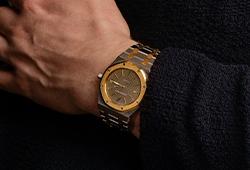Lena Cronqvist
"Skvallerbytta III"
Signed LC and numbered 4/5. Executed 1993-94. Foundry mark H. Bergman. Patinated bronze. Height 34, width 30,5 and depth 30 cm.
Provenance
Lars Bohman Gallery, Stockholm. Private collection, Sweden.
Literature
"Lena Cronqvist - Skulpturer 1993-1995", illustrated full page p. 67.
More information
Mårten Castenfors beskriver i sin essä ”Lena Cronqvist och det absolut nödvändiga”, SAK 2003, konstnärens måleri på 1990-talet som måleriska framställningar av små figuranter. Det är unga flickor som grimaserar i en värld av växtvärk, spelad oskyldighet och barnslig grymhet. ”1990-talets flickor vänder och vrider envetet på dockor och katter: de badar, dränker, stryper och bäddar med samma sorgmodiga välbehag.”
Flickorna, med sin trotsiga och allvarliga uppsyn, tycks placerade i en vuxenlös miljö där deras till synes oskyldiga lek är laddad med dunkla undertoner. Parallellt med att flickorna blir mer och mer vanartiga i måleriet finner motiven även sin tredimensionella form i Cronqvists skulpturer av terrakotta och brons. I såväl stor som liten skala utstrålar de små gestalterna psykologisk trovärdighet, självständighet och styrka. De styr och ställer och härskar över sin egen värld må det vara en sten, en balja eller ett vatten.
Motivet "Skvallerbytta" i tempera och olja på duk är daterat till 1991. (avbildat helsida s. 160 i "Lena Cronqvist, Målningar 1964-1994", Galleri Lars Boman, Stockholm, 1994). Motivet "Skvallerbytta" finns som skulptur i tre utföranden utförda 1993-94, varav auktionens skulptur är version III.
Artist
Lena Cronqvist is born and raised in Karlstad. Her interest for the arts came early in her life, and she spent the first year of her studies in England, near Bristol’s Art School. Upon her arrival back in Sweden, Cronqvist began a short-lived education at Konstfack, leaving to study painting at the Royal Academy of Fine Arts. When examining Lena Cronqvist's painting, it delves into "painting" in its more traditional sense. She is indeed a painter in the grand modern tradition, frequently turning to Edvard Munch and Francis Bacon’s art as inspirational sources. Yet she also had numerous art historical references and a deep love for the craft. Cronqvist excelled as a colourist, finding harmony in the most unusual colour combinations – few have managed to paint warmth and cold successfully at the same time. Her subject matter is often perceived as challenging and overly private by many. She often models herself for her art, posing in mundane situations imbued with a sharp psychological character. Her “Modonna-pictures” from the 1970s are a good example of this. She turns our gaze away from the conventional, notably in her portrayal and depiction of girls, which is fascinating. Cronqvist depicts these girls as ugly, simple, and altogether uncomfortable – a great contrast to how woman were normally portrayed in art. In more recent years, Lena Cronqvist has studied the effect of aging, using herself as a study. Moreover, Cronqvist is a very successful sculptor, and several of her works in bronze have been sold great sums in the auction world. She is also gifted in graphic productions, of which “Strindbergsmappen” is the most well-known. Among her most renowned works is "The Betrothal," a paraphrase of Jan van Eyck's symbol-laden painting "The Arnolfini Portrait." In Cronqvist's reinterpretation, artist and husband Göran Tunström are the main characters, with equally weighty symbolism but carrying entirely different meanings. Where van Eyck's painting features a loyal dog, Cronqvist replaces it with a cat—a symbol of independence.
Read more










































